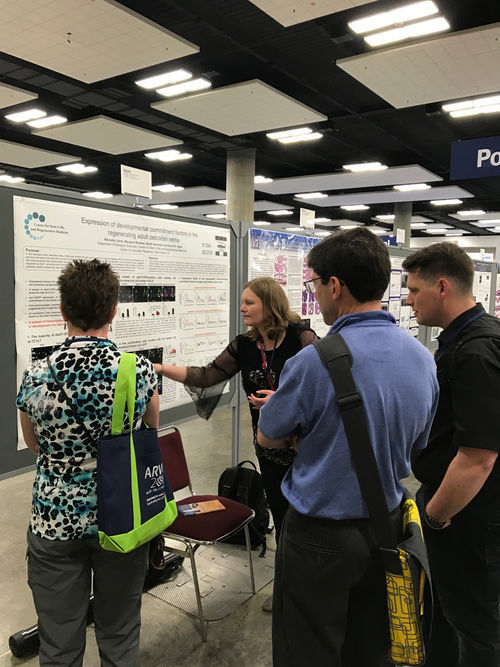
The ARVO 2018 Annual Meeting, held April 29-May 3, hosted 11,000 international basic and clinical researchers who shared the latest breakthroughs in vision research. Dr. Manuela Lahne, a Research Assistant Professor collaborating with Professor David Hyde in the Department of Biological Sciences and the Center for Stem Cells and Regenerative Medicine, received a 2018 SCRM Travel Fellowship allowing her to attend ARVO and present her current research data.
"I had the opportunity to present a poster entitled ‘Expression of developmental commitment factors in the regenerating adult zebrafish retina’ at the Annual Association for Research in Vision and Ophthalmology (ARVO) meeting in Honolulu, Hawaii. In contrast to the human retina, zebrafish have the ability to regenerate retinal cells that were lost due to damage (e.g., as a result of exposure to bright light). Müller glia, a stem-like cell in the zebrafish retina (and also present in the human retina), is activated by retinal damage to proliferate and produce new neurons that replace those that were lost. While several labs are trying to understand how these Müller glia are activated to proliferate, my poster presentation investigated which factors drive the differentiation of these proliferating cells into mature retinal neurons. I showed that the proliferating cells upregulate the expression of a subset of factors (atoh7, ptf1a, prdm1a) in light-damaged zebrafish retinas that are important for the commitment and differentiation of the different neuronal cell types in the developing retina. This suggests that these proliferating cells reuse some of the same signaling pathways that are involved in the generation of different neuronal types in the developing retina. Interestingly, a few transcription factors that are important for neuronal subtype specification in development (e.g., barhl2 and bhlhe5 for amacrine cells), did not increase in expression in the light-damaged zebrafish retina. This might suggest that additional regulators might be at play that control the formation of specific subtypes according to the cell types that were predominantly lost in the light-damaged retina. Understanding these mechanisms that regulate the different stages of retinal regeneration in zebrafish will ultimately help us to develop therapies to overcome vision loss in humans."